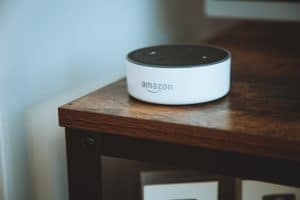Alexa…”, “Siri… “, “Okay Google….” hands up if you’ve said something similar in the last 24-hours? Yep, we thought as much.
It comes as no surprise that the pandemic has dramatically increased the amount of time people spend at home. But what most don’t realise is that this shift in routine has caused a ricochet effect. Certain industries have accelerated as our habits have been forced to change on a global scale. One of the best examples? Voice technology…
Voice technology isn’t a new thing, but 2020 has catapulted many of us into incorporating voice devices in our everyday life. Heading into the new year, it’s more important than ever that your brand can be found with voice. Why? We thought you’d never ask…
Why your organisation needs to be found with voice
- The increase in voice technology use
First things first, let’s look at the data. Vixen Labs have published the Voice Commerce Report 2020 to give recent and relevant insights into how people use voice technology. Based on a survey involving 1000 UK participants, 70% of voice device users are searching for specific brand-related information. 70%! And the trend is on an upwards trajectory. What does this mean? Voice has become a quick and easy way to get answers about a brand, that doesn’t require sifting through pages of internet results. Consumers are using voice technology to do their research on brands before committing to a purchase, so it has become a powerful tool that can contribute towards company revenue.
Voice technology has been embraced by a wide demographic. 40% of people use voice to make purchases, with parents being the most likely (presumably due to how time-effective and easy the technology is to access). So, whoever your target consumer market may be, voice use is on the incline across the board. For a more in-depth analysis on the current use of voice technology and the Voice Commerce Report data, check out our podcast episode with CEO of Vixen Labs, James Poulter on how and why your organisation needs to be found with voice. (Or alternatively, you could try saying “Okay Google, play SocialB Straight Talking podcast on Spotify”?)
- The impact of COVID-19 on voice search
Voice technology hasn’t come around overnight. Like most technological advances, as it becomes more advanced and prevalent, we naturally begin to adopt it. But COVID-19 has accelerated the use of voice devices beyond expectations, playing a key role in the population’s growing comfortability with the technology. The most obvious explanation is that voice devices are completely contactless. In a world where we’re striving to limit points of contact, voice technology fits in perfectly. While we won’t be in this state forever, the pandemic has initiated a change in our habits. Many people have started to integrate touch-free devices into their daily routines, casting a long-lasting effect on the use of voice technology.
What may come as a surprise in the Voice Commerce Report is that those who are often less-likely to embrace technological advances, for example, people aged 65+, are actively using voice devices. But why? Lockdown restrictions have isolated many people, particularly the older generation. Purchasing a voice device for this demographic became a popular way to keep people connected with a technological companion when spending time alone. This was possible because voice devices are way more affordable than other technology, and with campaigns giving out free devices (for example, Spotify gifting free Google Nest mini devices to their customers), voice has become widely accessible. Not only that, setting up this kind of technology is relatively easy. As most devices don’t have a visual screen, the added layer of complexity doesn’t exist which explains why the technology has been adopted by a wide demographic.
If the pandemic has taught us anything, it’s the power of human interaction. During the lockdown, it didn’t take long for people to get tired of screens and communicating through video calls. As a humanised alternative to visual tech, voice technology can optimise on this. Think about it, you’re sat chatting to your family about what to have for tea and wonder what time your local Dominoes is open until. Rather than grabbing your phone and mentally checking-out of the face-to-face conversation, you can use voice to get a quick answer and stay present. Of course, the use of screen-time won’t disappear post-COVID-19, but we’ll be more grateful for human interaction and, as a result, it can be expected that voice use will continue to grow.
- The future of voice technology
If you’re wondering how these trends affect your organisation, take a moment to think about your brand. Do you monitor site traffic and know what results consumers will get when searching for specific key words? We’ll presume the answer is yes (if not, check out our Small Business Guide to Digital Marketing free webinar). But ask yourself this; do you know what answer a voice device will give when asked a question about your company?
With people predominantly using voice for ease and quick answers, the future of voice technology lies in making people’s lives easier. If someone asks a question about your brand, it’s important the information is correct, readily available and that you control the narrative. Imagine you own a bakery and someone asks Alexa for the best cinnamon buns in your area. If your competitor down the road has already optimised on this, it doesn’t matter how great your buns are – consumers are only going to receive one answer and down to the competitor’s bakery they’ll go.
The Voice Commerce Report shows that people are becoming more familiar with voice devices. The technology is extending past household use, with 40 % of people use voice for their headphones or in the car. Voice is weaving its way into our lives and as a business, you need to get on the front foot of this trend. Now is the time to act, and here’s how…
How your organisation can be found with voice
Most brands know how to find what their audience searches for online and use traditional tools to track their rankings for keywords. In our SocialB podcast discussion, James explained that we can use these same tracking methods for voice, but rather than looking for keywords, the focus should be on questions. The main difference with voice technology, compared to text-based search, is that when we say something out loud, we naturally ask full questions (because let’s face it, it’d be weird to just randomly shout out keywords). Though 20% of smart speakers have visual aids, the majority are voice only. This lies in direct contrast to other technological devices, where consumers are assisted with visual aids, auto-fills, and previously searched suggestions. None of these prompts exist in voice.
Voice devices will only read out one answer; the answer it deems best answers the question. So, rather than replicating your usual aim to rank in the top 10 links of search engine results, you need to be at what’s coined ‘position zero’. Position zero is above those top 10 links and is the only position the audio device will read out.
How to reach position zero in voice technology
- Start with the usual key terms associated with your brand, then focus on what types of questions people may ask around these key terms. Think about your customer’s pain points and what answers they may need before buying into your brand.
- Resources like the Alexa Agency Curriculum are a great starting point for voice marketing. Most voice searches are looking for content, so focus on optimising your applications, video, and audio content to answer your customer’s questions. If you do this well, it becomes extremely powerful, as you’ll be the only result the device will present. At the moment there is no advertising on these platforms so position zero has to be worked for organically, with quality and well-positioned content.
- No matter how you decide to conduct voice marketing, your content must be helpful. The whole point of this technology is to provide quick and accurate information, so the algorithms are programmed to search for the most helpful answer.
- Once you’ve developed a voice marketing strategy and started to create content, there aren’t many tools to track whether searches on your page are coming from voice devices. But don’t let this stop you! A key indicator is whether long-tail, question-based keywords are driving people to your site – if this is the case, this traffic is likely coming from voice. Tools are being developed each day, so if you can start recognising voice traffic now, you’ll be ahead of the game once tracking tools are fully developed.
With the rise in use of voice devices, brands need to optimise on this technology sooner rather than later. 2021 is predicted to be a year where organisations shift their marketing focus to voice search, striving to answering queries and common questions with clear and concise content. People of all age groups are becoming more comfortable using voice, and as the younger generation continue to push the boundaries of the technology, it’ll be propelled into the future. Our advice? Don’t get left behind.









